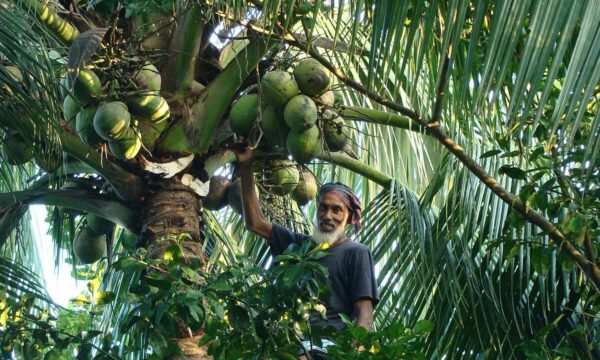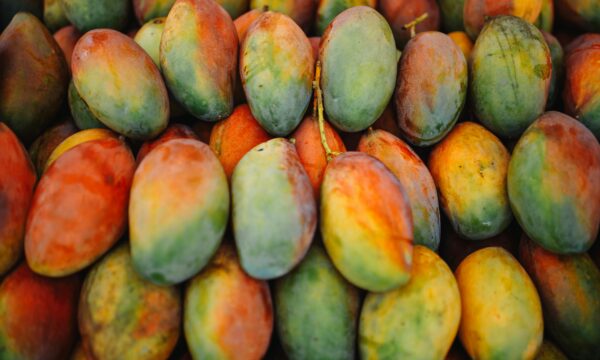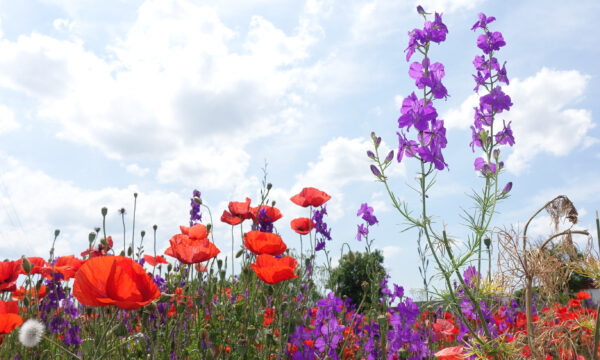
- An adult male coconut rhinoceros beetle. Emmy Engasser, Hawaiian Scarab ID, USDA APHIS ITP, Bugwood.org
10 years ago the Coconut Rhinoceros beetle (CRB) was first discovered on the western Pacific island of Guam. Since then, these shoe-shine black, miniature invaders have spread to all parts of the island and are laying waste to the local coconut and oil palm population. The economy, culture and ecology of Guam and other Pacific islands are intrinsically linked to the native palm species such that the rhino beetle poses a major threat. The indigenous peoples of Guam have a long history of weaving palm fronds, an artistry that is now at risk due to the rhino beetle. These trees are a symbol of tropic paradise, a motif that drives Guam’s primary industry; tourism.
The situation

A coconut palm damaged by CRB © Aubrey Moore
The principal method of rhinoceros beetle control is through the release of a virus specific to CRB known as Oryctes rhinoceros nudivirus (OrNV). As a biological control strategy, it has been highly effective at keeping CRB populations low and thus lessening palm damage by up to 90% (Bedford, 2013).
Up until Guam, 2007, it had been 40 years since an outbreak of CRB on an uninfested palm growing Pacific island, owing to the persistence of OrNV in beetle populations. Early attempts at disseminating the virus in the new Guam population proved surprisingly ineffective. Upon DNA analysis, the invading rhino beetles were found to be genetically distinct from CRB native to other Pacific regions. The Guam population was deemed a new biotype (CRB-Guam) and was found to be resistant to all available OrNV strains.
This resistance has proved paramount to the invasive ability of CRB. As well as Guam, the new biotype has now been logged in Papua New Guinea (2009), Palau (2014), Hawaii (2014) and the Solomon Islands (2015) (see figure 1). There is now a real threat of a Pacific-wide outbreak of CRB. Smaller islands, where traditional, palm-dependent economies still operate, stand to suffer the most.
The passing of Typhoon Dolphin over Guam in 2015 highlighted the dangers of an event like this triggering rapid growth in CRB populations. Downed trees and vegetative waste make ideal breeding sites for the beetle. A positive feedback system may be initiated whereby more breeding sites allow for larger populations which kill mature palm trees which, in turn, become breeding sites for subsequent generations.
What can be done?
Numerous management techniques have been attempted on Guam since 2007. In March 2012, the Plantwise Knowledge bank reported on a promising new biological control method, the Metarhizium fungus. The fungus is specific to rhino beetles and the CRB-Guam biotype appeared susceptible to it. Unfortunately, it has not proved as effective as once thought and the Guam beetle population persists at damaging levels.
General sanitation practices that involve keeping areas free of green waste help to reduce the number of breeding sites, invariably limiting the potential for CRB population growth. However, this task proves tricky on a 210 square mile island covered in dense jungle and off-limits military bases.
Previously, specially trained detector dogs were used to root out rhino beetle breeding sites. This method, however, proved expensive and hard to reach areas were beyond its capability. More recently, new radio tracking technology has been proposed as a more cost-effective alternative. Small radio transmitters are glued to adult rhino beetles, these are then released and tracked back to previously unknown breeding sites. In August 2015, a 10-day field trial was carried out with some success.
As concern surrounding CRB mounts, the U.S. Department of Agriculture’s (USDA) Animal and Plant Health Inspection Service (APHIS) has announced funding worth $1.7 million, to go to Hawaii and Guam, with aims at combating the spread of this tenacious pest.
For Guam at least, complete eradication seems evermore unlikely. It appears the island’s best chance is population suppression and management. Aubrey Moore, an entomologist at the University of Guam, who has been working on CRB ever since it’s first appearances on the island, says that current work focuses on finding an OrNV isolate that the CRB-Guam biotype is susceptible to.
Jack Sayers is a Biological Sciences student at the University of Edinburgh, with a particular interest in genetics. He has spent his summers working for CABI as part of the Plantwise team.
References
Bedford, G. O. (2013) Long-term reduction in damage by rhinoceros beetle Oryctes rhinoceros (L.) (Coleoptera: Scarabaeidae: Dynastinae) to coconut palms at Oryctes Nudivirus release sites on Viti Levu, Fiji. African Journal of Agricultural Research 8(49) pp. 6422-6425
Marshall, S. D. G., Moore, A. and Vaqalo, M. (2016) A New Coconut Rhinoceros Beetle Biotype Threatens Coconut and Oil Palms in Southeast Asia and the Pacific. Western IPM Center.
1 Comment
Leave a Reply
Related News & Blogs
5 common chilli pests and diseases
Chilli pests and diseases can considerably impact crop production. Not only can pest and disease outbreaks lead to severe yield losses, but they also reduce quality and lower market value. In many countries, including India, Bangladesh, Malawi, and Tha…
12 June 2025







[…] September 18, 2017September 18, 2017Jack Sayers […]